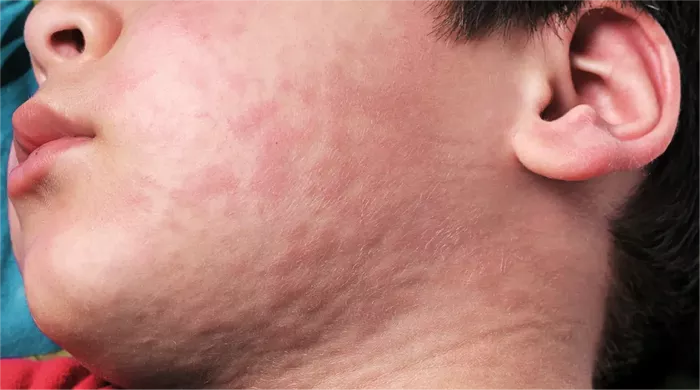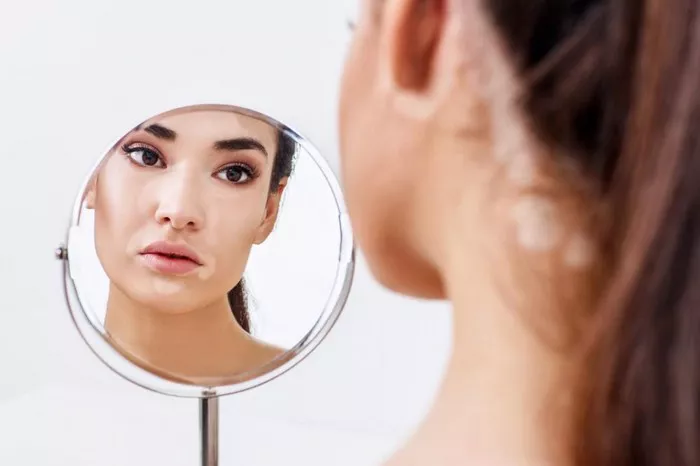Hives, medically termed as urticaria, are a common skin condition characterized by raised, red, itchy welts on the skin. While hives can occur anywhere on the body, when they specifically manifest on the face, they can be particularly distressing due to their visibility and potential discomfort. Identifying the root causes of facial hives is crucial for effective management and prevention. In this comprehensive article, we delve into the intricate factors that trigger hives on the face, shedding light on the mechanisms behind this perplexing dermatological phenomenon.
The Skin’s Reaction: A Complex Interplay
The skin acts as a barrier, shielding the body from external threats while regulating internal temperature and moisture levels. When faced with certain triggers, however, this barrier can become compromised, leading to an array of reactions, including hives.
Allergies: Culprits from Within and Without
Allergic reactions are among the primary instigators of facial hives. Individuals may develop sensitivities to various allergens, both environmental and ingested. Common allergens include pollen, pet dander, certain foods (such as nuts, shellfish, and dairy), medications, and insect stings. Upon exposure to an allergen, the body’s immune system releases histamine and other chemicals, triggering inflammation and the characteristic welts associated with hives.
Stress: A Hidden Aggravator
The mind-body connection plays a significant role in dermatological health, with stress serving as a potent exacerbating factor for facial hives. Stress stimulates the release of cortisol and other stress hormones, which can disrupt the immune system and exacerbate inflammation. Additionally, stress-induced behaviors, such as scratching or rubbing the face, can further irritate the skin, exacerbating hives.
Environmental Factors: Nature’s Influence
Environmental factors, ranging from temperature extremes to pollutants, can trigger hives on the face. Exposure to harsh weather conditions, such as extreme cold or excessive heat, can disrupt the skin’s barrier function, making it more susceptible to hives. Similarly, pollutants and irritants present in the air, such as smoke or chemical fumes, can provoke allergic reactions and skin irritation, manifesting as facial hives.
Skin Irritants: The Hidden Dangers
Daily skincare and cosmetic products, while intended to enhance the skin’s appearance, can sometimes contain ingredients that trigger adverse reactions, including hives. Common culprits include fragrances, preservatives, and harsh detergents found in cleansers, moisturizers, and makeup. Even seemingly innocuous products, such as facial wipes or sunscreen, can harbor irritants that provoke hives in sensitive individuals.
Underlying Health Conditions: The Intricacies of Internal Imbalance
Facial hives can also serve as a manifestation of underlying health conditions, underscoring the intricate interplay between skin health and overall wellness. Autoimmune disorders, such as lupus or thyroid disorders, can cause inflammatory reactions that present as hives on the face. Similarly, infections, such as viral or bacterial pathogens, can trigger immune responses that result in facial hives as the body’s defense mechanisms kick into overdrive.
Genetic Predisposition: Unraveling the DNA Blueprint
Genetics can predispose individuals to certain skin conditions, including hives. Family history can play a significant role in determining an individual’s susceptibility to allergic reactions and skin sensitivities. While genetic predisposition alone may not cause facial hives, it can amplify the body’s response to environmental triggers, making individuals more prone to developing hives on the face.
Medication Side Effects: Balancing Benefits and Risks
Certain medications, while instrumental in treating various ailments, can inadvertently trigger hives as a side effect. Antibiotics, nonsteroidal anti-inflammatory drugs (NSAIDs), and anticonvulsants are among the medications commonly associated with drug-induced hives. It is essential for individuals to communicate any adverse reactions to their healthcare providers promptly to explore alternative treatment options and mitigate the risk of further complications.
Treatment and Management: Navigating the Path to Relief
Effective management of facial hives hinges on identifying and addressing the underlying triggers while alleviating symptoms to enhance quality of life. Antihistamines, both oral and topical, are the cornerstone of hives treatment, providing relief from itching and inflammation. Additionally, corticosteroids may be prescribed for severe cases to quell immune responses and reduce swelling. Lifestyle modifications, such as stress reduction techniques and avoidance of known triggers, can complement medical interventions in preventing recurrent episodes of facial hives.
Conclusion
Facial hives, though often benign, can be a source of significant discomfort and distress for affected individuals. By unraveling the diverse array of factors that contribute to the onset of facial hives, we can empower individuals to take proactive steps in managing their condition and optimizing skin health. Through a multifaceted approach encompassing medical intervention, lifestyle modifications, and heightened awareness of potential triggers, individuals can regain control over their skin and embark on a journey toward lasting relief and well-being.



























